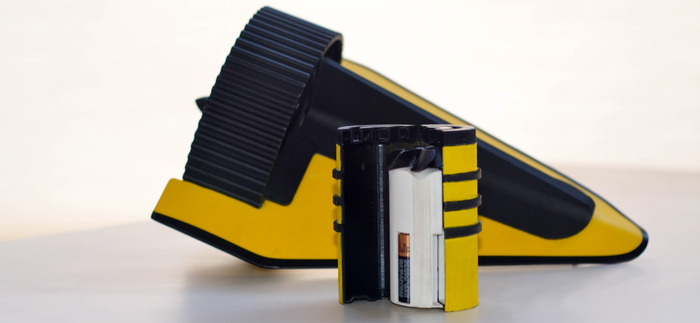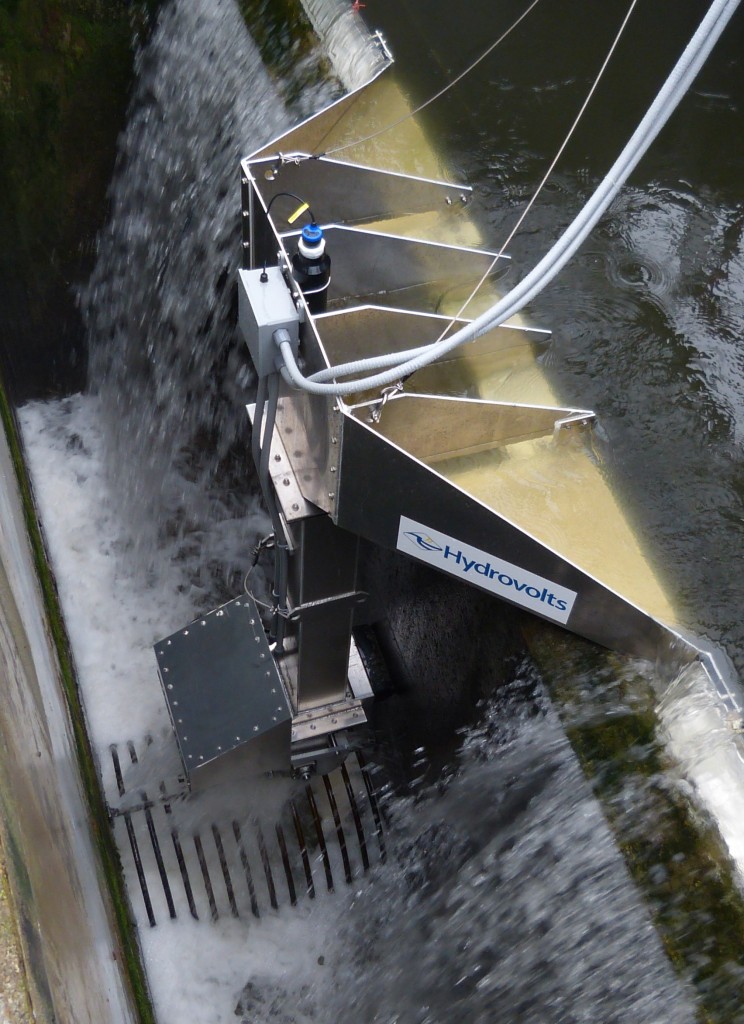Energy harvesting is a buzzword that has been cropping up quite a bit recently. Anything from hand-crank generators and solar panels to yo-yos and TMNT Shredder masks can be potentially used to generate power for your mobile devices. Of course, only some of these harvesters have made it to market because it turns out that there isn’t much energy in your yo-yo or lungs to be harvested. So what about the local river?
What is it?
Hydrobee claims to be a pair of devices that can be used to generate power from running water. The small cylinder contains an impeller and some “clever electronics” that together charge the six AA NiMH batteries also stored inside. This cylinder gets its power by mounting on a sink faucet, but it can also be installed in the floating stream/river body which provides the small cylinder with a larger impeller. Once the batteries are charged, a phone can be connected via USB.
A lot of thought seems to have been put into this device. The cylinder is the size of a soda can to aid in global distribution; swapping the can out allows you to continue to generate power even while your phone is charging; the larger and smaller impellers share a drive shaft to cut down on parts, the cylinder’s case is made from two mirrored halves to cut down on the number of mold parts…. It’s clearly a design that creator Burt Hanner cares about.
Can it work?
What does he have working today? With devices that ship in five months (April), we are always a little skeptical of how well the project creators have scoped their projects. Burt has over five years of experience with a hydro-power company that he founded, but designing portable consumer-grade devices is very different from the industrial hydroelectric power plants he’s used to:
So how far has he come? Well, although it’s somewhat implied, Burt never claims that the Hydrobee prototype actually works. There are also some issues with his demonstrations. For example, the image at the top of this page shows the device charging Duracell non-rechargable batteries, and Burt runs into a little trouble during his USB demonstration:
Also, the impeller in the Hydrobee doesn’t appear to rotate at all when placed in a stream:
Which isn’t too surprising considering it was 3D printed and printed components rarely have the tolerances required to work in mechanical systems.
He does say that this concept has been demonstrated to work with a flow meter, but that’s a far cry from his yellow and black bullet:
Though even this demonstration is a bit dubious. He seems to be fixated on the 18V output of this thing mentioning it both in his video and project description:
The problem is that 18V doesn’t tell you anything. The average static shock is on the order of tens of thousands of volts, but you don’t see anyone charging their phones with wool socks or a particularly fuzzy feline. The question shouldn’t be how many Volts it can put out, but how many Watts. Someone who has a long history of working with hydroelectric power should understand this distinction though he does mix up “propeller” and “impeller” several times throughout his video and description, so I’m not so sure.
Alright, so maybe his marketing is a little off-message, but the question remains: is what he’s claiming even possible?
<WARNING, SCIENCE AHEAD>
Let’s talk about the stream/river attachment. This is an example of a “low-head” or “hydrokinetic” generator. This means that the generator has no need for a dam to collect water but instead draws power off the motion of water in a stream or river.
So how much energy is available in moving river water, and is it enough to provide the power to charge 6 AA NiMH batteries in 2 hours as claimed? I’m going to start with the most favorable conditions and then back it down from there.
The above claim is made with the condition that the river is moving at 4MPH. I’m going to estimate that the impeller on the river body attachment is about 8 inches in diameter (a little over 3x the diameter of the battery cylinder) or has an area of 50 square inches. This gives us 58 liters per second of water flowing through the impeller. Now let’s assume that all of the kinetic energy of this body of water is converted into electrical energy. This would require the water leaving the impeller to be moving at 0MPH, but again, we’re being favorable here. This is the theoretical maximum.
58 liters of water traveling 4MPH has a kinetic energy of 92.7 Joules. If this passes through the impeller once per second, the impeller would generate 92.7Watts of power. Of course, this is assuming perfect efficiency while a more reasonable number found online would be 54-59% of that. Let’s round down to 50 to be safe; it’s around 45 Watts of output power.
So now the question is how much power do you need to charge 6AA batteries in 2 hours? The page says the batteries store a combined 15,000mAh at nominal 1.2V. That’s 64,800 Joules. When provided over the course of 2 hours, that’s an average of 9 Watts.
So yes! That’s reasonable. Even when factoring in the typical efficiency of this kind of power generation, we’re getting more than five times the power required to do what Burt is claiming. There are a few additional troublesome bits like the fact that his video shows the impeller only half-submerged, but the take-home is that he is clearly not inventing numbers here.
Can he do it?
Five months is not a lot of time. It’s an especially short period for someone with little or no consumer product experience to pump out a sophisticated and water-proof electromechanical device ready for mass production. Waterproofing is what I’m most concerned about. He claims to be getting help from the University of Washington School of Oceanography, but no other details are given as far as product testing go. A lot can go wrong with a device running in outdoor underwater environments, and with no functioning waterproof prototype, he hasn’t demonstrated that he knows that.
I think Burt has a really cool idea for a product that could help a lot of people, but I think he’s going to run into a lot of trouble when it comes to running some durability testing on an actual prototype.






Hey Choof,
Interesting breakdown of your concerns and criticisms with the project. It looks like there is a week to go on Kickstarter for Hydrobee and still some money to be raised. If people are wanting to get this built, they need to act now!
We’re back after winning a number of awards for design (yes it is even better)! Now we are on Indiegogo http://bit.ly/hydrobeeIGG
I’m lucky that I found this web site, just the right info that I
was trying to find!
Check out my web-site – macbook stickers star wars (Ahmad)
Er du derimod ude etter at få godt internet til en billig penge er
du bestemt kommet ttil det rette sted.